

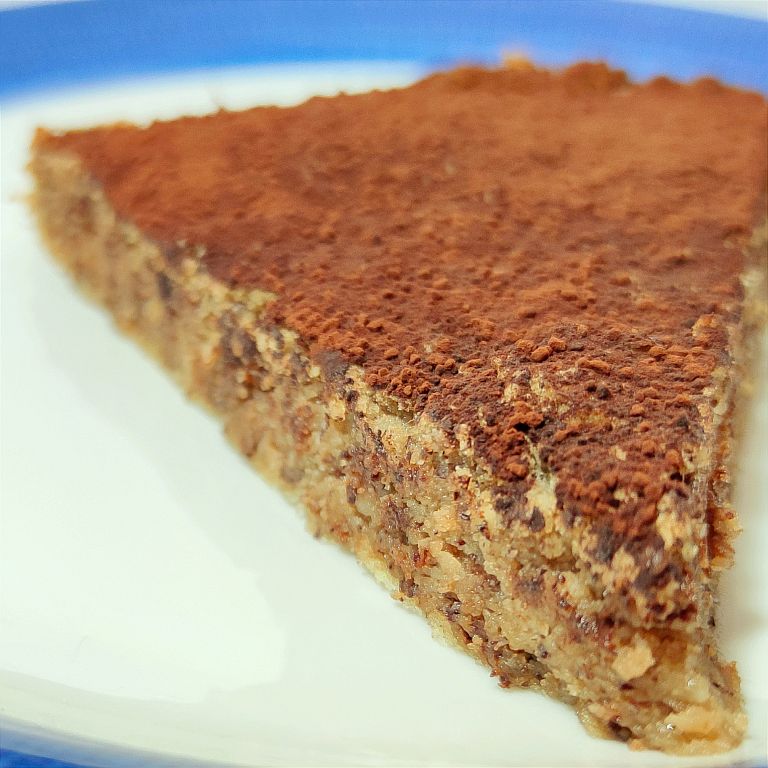
Chestnut cakes are traditionally prepared mainly in France. They are often recipes that are naturally gluten-free or perhaps only require a tablespoon of flour, which can easily be substituted. The starch that gives the cake its structure comes here almost exclusively from the chestnuts themselves.
The finely nutty, sweet note of the chestnuts comes into its own in this recipe for chestnut cake and harmonises well with the hazelnuts and almonds. The chocolate shavings give the cake a fine chocolate note without it being too dominant and covering the chestnut note.
In this recipe, I made sure that the chestnut purée, which gives the recipe its name, really makes up a large part of the recipe and that as little as possible of another structuring ingredient is used. I also wanted to limit the amount of eggs to the most necessary, unlike some recipes circulating on the internet that call for 6 or more eggs. I also did not make the cake overly sweet to let the sweet inherent note of the chestnuts fully come to the fore.
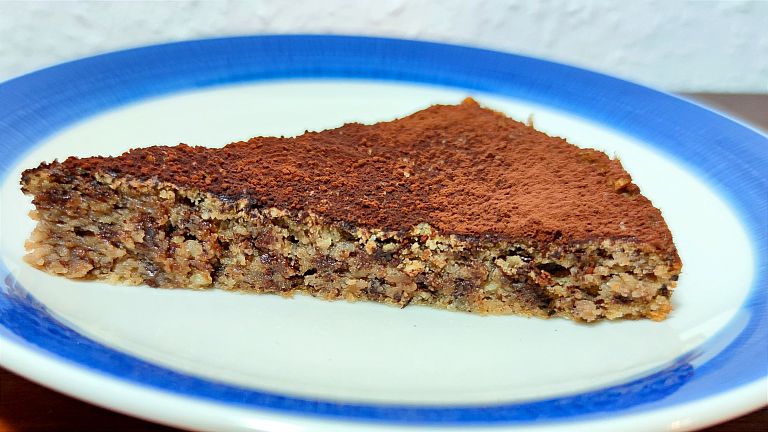
Chestnuts have been a staple food in southern Europe since the early Middle Ages, from Portugal across the Alps to Greece. Especially in barren mountain landscapes where no grain could grow, they were the most important and often the only food plant. Depending on the region, one to two trees were estimated to feed an adult person all year round. It was not until the 20th century that the sweet chestnut lost its importance for human nutrition and fell somewhat into oblivion.
However, there are some exceptions. Especially in southwest Germany, chestnuts roasted in their shells are considered a delicacy. I can remember bisiting winter markets when I was a kid where roasted chestnuts were offered fresh from the roasting oven at small stalls. You could easily burn your fingers and mouth on the hot chestnuts. In addition, France and in the north of Italy, sweet dishes were made with sweet chestnuts, such as the preparation for Mont Blanc or Monte Bianco, for which sweetened chestnut cream is pressed through a potato press, through which the cream takes the form of fine threads.
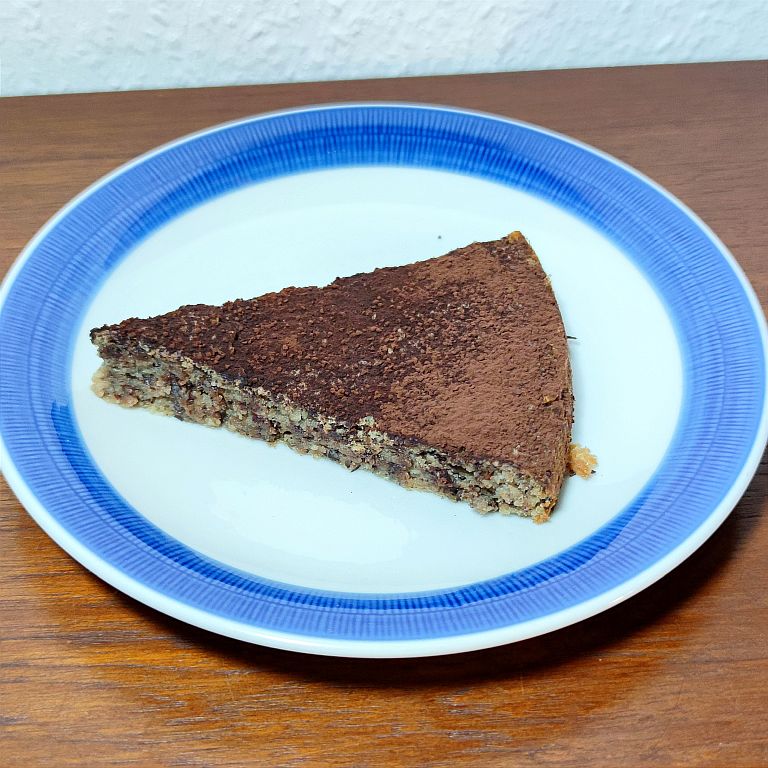
I baked the cake here with half a tin of chestnut puree, 220 g, because I used the remaining contents of the tin for a chestnut and potato puree for the main course. I used a round baking tin with a diameter of 24 cm and thus got a flat cake, like a French tarte. The good thing about making it this way is that it gives the cake a short baking time because it is spread so flat in the tin. You could just as easily bake this recipe quantity in a small baking tin designed for "half quantities". These usually have a diameter of 16 or 18 cm.
Of course, you can also double the recipe quantity so that a whole tin of chestnut purée is used. In this case, you should calculate the baking time at approx. 45 min and, to be on the safe side, do a cooking test with a wooden stick or a fork - if you poke the stick into the middle of the cake and can pull it out again without any dough sticking to it, the cake is done.
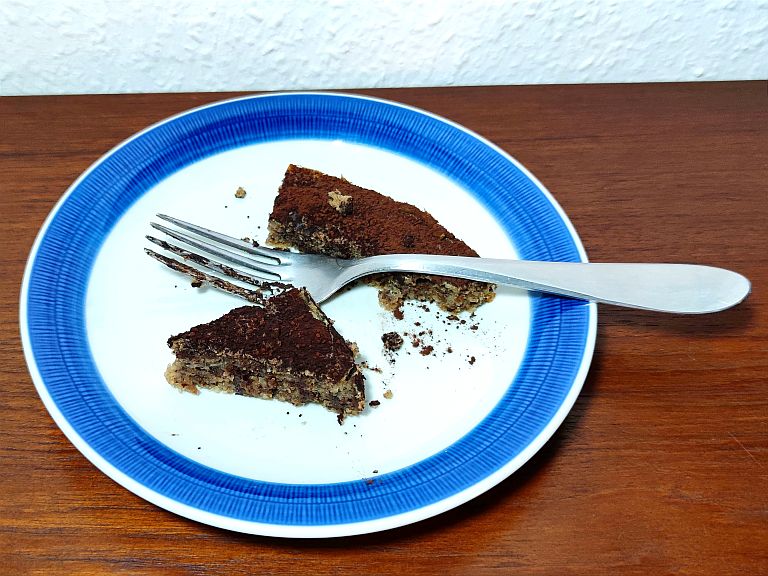
I used chestnut puree from a can because it already has the perfect consistency for use in cakes or savoury dishes. It is fine and homogeneous, without pieces of chestnut, and becomes creamy when prepared. However, it is not available everywhere, in Germany only in well-stocked supermarkets in the international food aisle.
But you should be careful to use chestnut puree and not chestnut cream. There are different product categories that can easily be confused. In addition to approx. 60 % chestnuts, commercial chestnut puree also contains water, salt and possibly a small amount of sugar. Chestnut cream, on the other hand, is more heavily sugared. It contains up to 50% sugar and is more suitable as a spread, but unfortunately not for this recipe.
If ready-made chestnut puree is not available, you can also use whole chestnuts that are cooked and vacuum-packed. For this recipe, you can puree the chestnuts well with the egg yolk, sugar and butter in a stand mixer. The whole chestnuts contain less water than the ready-made chestnut puree from the tin. If the mixture becomes too firm, add a little water by the tablespoon until the desired consistency is reached.
I really advocate making the extra effort to separate the eggs and whisk them separately! You will see that it is worth it! The beaten egg whites give the cake an optimal airiness and light fine structure. If you beat the eggs whole, the recipe will certainly work, but I'm afraid the cake will be a little flatter and more compact and not as fluffy and cloudy.
Can you make the cake without eggs? I'm afraid that with the usual methods of replacing eggs - such as Chia Egg or Flax Egg - it won't achieve a comparable result. The beaten egg whites are too important here as a loosening agent. To be honest I don't know enough about plant-based egg substitutes to be able to name a commercially available product that can successfully replace the eggs in this recipe. However, I will be happy to work on a purely plant-based version of the chestnut cake and keep you posted here.
Hazelnuts are the first option for me when it comes to combining with chestnuts. If you don't have ground hazelnuts on hand, you can substitute them with another type of ground nut. A good option would be ground almonds with shell. Other types of nuts such as walnuts, cashews or pecans would probably need to be ground in a food processor as they are rarely available in the shops in this form.
One way to make a nut-free version of the cake without sacrificing the nutty taste would be to use ground tiger nuts. Tiger nuts are not nuts, but the root tubers of a sedge grass that grows underground. They are therefore absolutely free of nut allergens, but have a nutty, slightly sweet taste. You are welcome to use them here. However, since tiger nuts bind much more water than nuts, I would recommend halving the dosage first.
I used the ground blanched almonds here to adjust the consistency of the dough. Without the ground almonds, the dough seemed too moist and soggy to me. And ground blanched almonds, in my experience, absorb more moisture than ground hazelnuts. So I refrained from simply using 20 g more ground hazelnuts. Instead, you can also use starch or another gluten-free flour - for example buckwheat flour, millet flour or corn flour. Chestnut flour would of course also be an option - then you would have even more chestnuts in this cake. If you substitute coconut flour for the ground almonds, you should halve the amount.
For a naturally sweetened, Paleo version of this cake I am using coconut blossom sugar. If you don't have any at hand, you can also use brown cane or beet sugar. Since chestnuts are naturally very rich in starch, there is no way to make the cake low carb in any way. But to lower the sugar content respectively carbohydrate content, you can use a granulated sweetener of your choice - both xylitol and erythritol are good for baking.
I seasoned the chestnut cake with a little vanilla extract, because I find that the subtle flavour of the ingredients comes out best that way. However, as chestnuts are in season in autumn and winter and the chestnut cake tends to be served in winter, you can also refine the dough with wintry, Christmas spices such as cinnamon, cardamom or a mixture like Pumpkin Pie Spice.
The chocolate shavings give the chestnut cake a fine chocolate note. I'm quite happy that I don't have to go to the trouble of melting the chocolate over a bain-marie. This is always quite a mess and when I have tried to melt the chocolate in the microwave oven, often something has gone wrong and the chocolate has ended up burnt.
Besides, the slightly irregular texture that results from the fine chocolate shavings goes well with the grated hazelnuts. Since these are grated with the shell, they also have a slightly irregular appearance with brown particles.
I used low-fat cocoa powder here to decorate the top of the cake. I think the cocoa powder gives it a truffle-like appearance, which goes well with the decadent, moist taste. Alternatively, you can dust it with icing sugar or a mixture of icing sugar and cinnamon, or if you prefer to eat cake with your fingers, don't do it at all. A more luxurious way to garnish the cake would be to spread it with chocolate ganache. I could also imagine a cream cheese frosting.
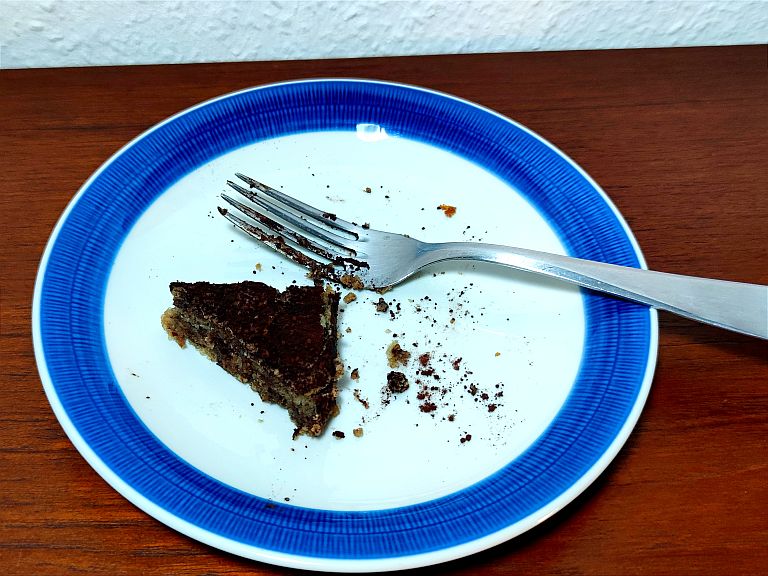
I think whipped cream goes best with all sweet recipes with chestnuts, perhaps garnished with a few chocolate shavings. The mild, nutty, dense taste of the chestnut harmonises fantastically with the cool, melting cream.
I could also imagine a fruit compote with it. For me, cherries, pears or apples would be the first choice.
Chestnut puree gives this chestnut cake its fine, sweet, nutty flavor and rich, fluffy structure. Packed with hazelnuts and dark chocolate, it has what it takes to become your favorite cake.
Separate the eggs. Beat the egg whites with the whisk of the hand mixer in a small mixing bowl until stiff peaks form.
Beat the egg yolks, butter and sugar with the whisk of the hand mixer in a larger mixing bowl until the mixture is soft and fluffy.
The chestnut purée should have a soft, malleable consistency. If it is too firm, heat it in the microwave for a few seconds until it has softened enough to mix well with the other ingredients.
Mix the chestnut purée with the egg yolks and sugar. Add the ground hazelnuts and almonds, salt, baking powder and vanilla extract and stir until a homogeneous mixture has formed.
Using a spatula, carefully fold the beaten egg whites into the rest of the batter. There should be as little stirring and pressure as possible so that the cake later remains as airy as possible, but the beaten egg whites should be homogeneously distributed.
If you don't have ready-made grated chocolate or other small chocolate pieces, grate the dark chocolate bars on a kitchen grater.
Fold the grated chocolate into the batter.
Grease a round baking tin and dust it with any gluten-free flour (I can recommend coconut flour). Spread the batter in the tin and smooth it out.
Bake the cake at 180°C convection oven for about half an hour. Before removing from the oven, test whether the cake is thoroughly baked with a wooden stick.
Leave the cake to cool on a cooling rack before removing it from the tin. Put the cocoa powder in a flour sifter and decorate the top of the cake with it.
Thank you for your interest in this Zucchinista recipe!
Please drop a comment below the recipe card if you have any questions, concerns, or need help troubleshooting! I am so happy to hear from you how your recipe turned out!